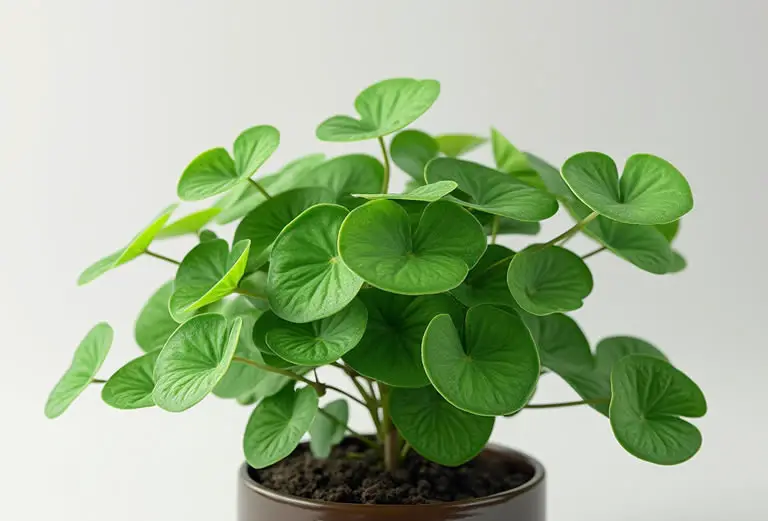The Chinese Money Plant (Pilea peperomioides) has become one of the most recognizable houseplants in the world—and with good reason. Its perfectly round, coin-like leaves and fountain-shaped form make it a playful, cheerful addition to any space. It’s also easy to care for and produces baby offshoots like crazy, making it one of the most shareable plants around.
Here’s how to keep this quirky beauty happy, healthy, and thriving for years to come.
Table of Contents
- Pilea peperomioides
- Light Needs: Bright Light Keeps It Compact and Happy
- Watering: Keep It Light but Consistent
- Humidity and Temperature: Flexible but Not Freezing
- Fertilizer: Feed Lightly for Healthy Growth
- Soil and Repotting: Loose and Well-Draining Is Ideal
- Pruning and Maintenance: Easy to Shape and Share
- Best Spot in the Home: Bright and Breezy Rooms
- Feng Shui Use: A Symbol of Abundance and Harmony
- Outdoor Care: Warm Weather Display Only
- Common Problems and Fixes
- Final Thoughts
Pilea peperomioides
Native to the forested slopes of Yunnan, China, Pilea peperomioides is a member of the Urticaceae family.
It was relatively unknown outside of China until the 1940s, when it was brought to Europe by a Norwegian missionary—earning it the nickname “pass-along plant” due to its fast-growing pups and generosity.
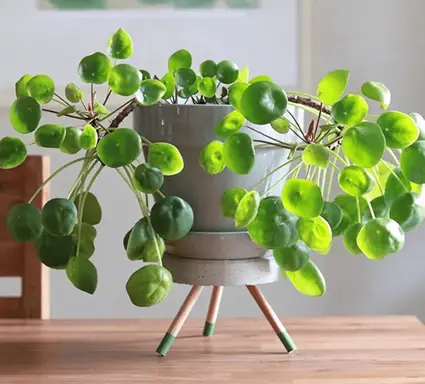
It’s also called Pancake Plant, UFO Plant, and Missionary Plant, all thanks to its perfectly round leaves on long petioles.
Though once rare, it’s now a must-have for any stylish indoor garden.
Light Needs: Bright Light Keeps It Compact and Happy
Chinese Money Plants love bright, indirect light.
A north or east-facing window is perfect, or you can place it a few feet back from a south or west-facing one.
Too much direct sun can scorch the leaves, while too little light will cause the plant to stretch and become leggy.
Rotate the plant weekly to keep it growing evenly and maintain its pleasing shape.
Watering: Keep It Light but Consistent
Let the top inch of soil dry out between waterings.
Water deeply when you do, then let all excess water drain away.
Avoid letting the plant sit in soggy soil, as this can lead to root rot.
Reduce watering in winter when growth slows.
If the leaves start to droop, that’s your cue to water.
Humidity and Temperature: Flexible but Not Freezing
Pilea prefers moderate humidity but adapts well to average indoor levels.
If the air is especially dry, mist occasionally or place it near other plants to share humidity.
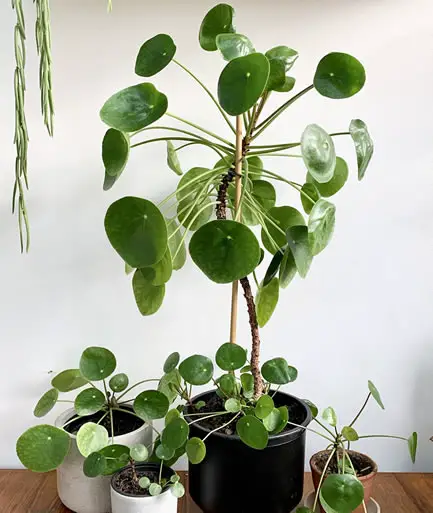
It grows best in temperatures between 60°F and 75°F and should be kept away from cold drafts and sudden temperature changes.
Fertilizer: Feed Lightly for Healthy Growth
Feed once a month during spring and summer with a balanced liquid fertilizer diluted to half strength.
Look for a houseplant formula with an NPK ratio like 10-10-10 this one, or 20-20-20 this one.
Skip fertilizing in the winter months when the plant naturally slows down.
Too much fertilizer can cause salt buildup and damage the roots, so less is more with Pilea.
Soil and Repotting: Loose and Well-Draining Is Ideal
Use a lightweight, well-draining potting mix—standard indoor potting soil blended with a little perlite or sand works well.
Repot every 1–2 years, preferably in spring, or whenever the plant becomes root-bound.
Choose a pot with drainage holes to prevent excess moisture buildup.
Pilea stays naturally tidy, but you can prune back leggy growth to encourage fuller foliage.
Snip off any yellowing or damaged leaves at the base.
Most plants will send out baby plants (pups) around the base or from the roots.
You can leave them to grow, or separate them for propagation and pot them up as gifts.
Consider using healthy cuttings to grow new plants as we outlined how to do in our article How to Propagate Pilea peperomioides (Chinese Money Plant) Easily.
Best Spot in the Home: Bright and Breezy Rooms
This plant is perfect for bedrooms, kitchens, or bright living rooms with indirect sunlight.
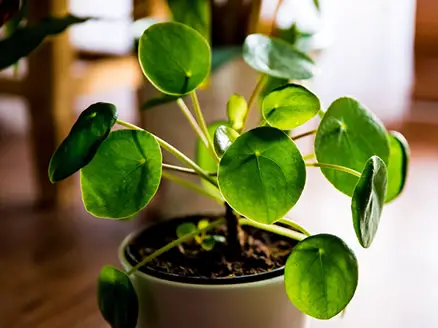
It loves being near a window but not directly in the sun. Its clean, upright growth habit makes it ideal for small spaces, bookshelves, or plant stands.
Feng Shui Use: A Symbol of Abundance and Harmony
In Feng Shui, the Chinese Money Plant is thought to attract prosperity, good luck, and positive energy.
Its round, coin-like leaves are symbolic of wealth, and placing it in the southeast corner of your home or office is said to enhance financial well-being.
Even if you’re not deeply into Feng Shui, its cheerful form and balanced growth naturally bring a sense of harmony to any space.
Outdoor Care: Warm Weather Display Only
In USDA zones 10–12, Pilea can be grown outdoors year-round in shaded areas.
In cooler zones, it can spend late spring through early fall outside on a shaded patio or balcony. Avoid direct sun and bring it indoors when temperatures fall below 55°F.
Be sure to check for pests before bringing it back inside, and give the leaves a gentle rinse.
Common Problems and Fixes
Drooping leaves are usually a sign of underwatering or dry soil
Fix it by soaking the soil thoroughly and allowing it to drain completely
Leggy growth means the plant isn’t getting enough light
Fix it by moving it closer to a bright window and rotating regularly
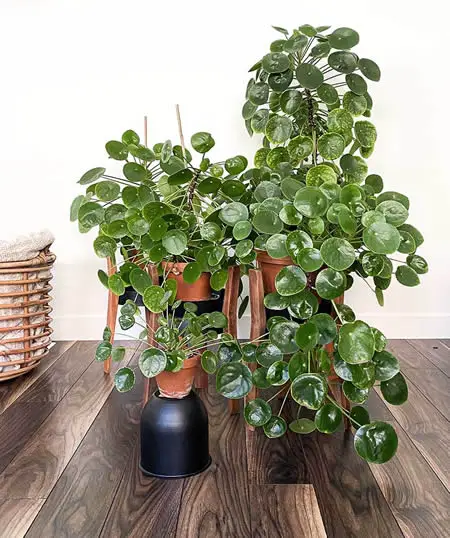
Yellow leaves often point to overwatering
Fix it by letting the soil dry out more between waterings and ensuring the pot drains well
Curled or crispy edges may be caused by low humidity or salt buildup
Fix it by misting the plant occasionally and flushing the soil every few months
Leaf drop can occur after sudden moves or changes in light
Fix it by placing the plant in a stable, bright location and giving it time to adjust
Final Thoughts
The Chinese Money Plant is a joyful, generous houseplant that’s easy to love and even easier to grow.
With just the right amount of light, a simple watering schedule, and an eye for baby pups, this plant will thrive in your home—and likely in your friends’ homes too.
Its unique look, shareability, and adaptability make it a treasured classic in any houseplant collection.

